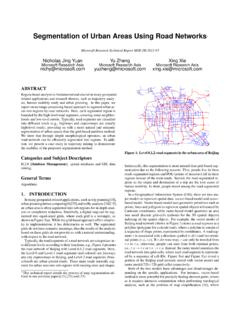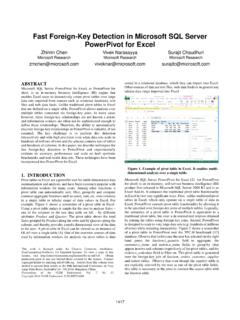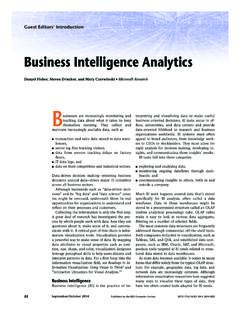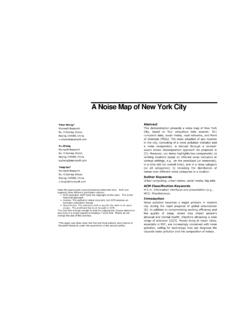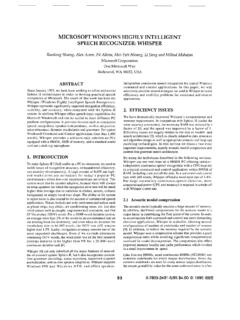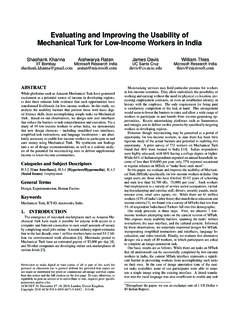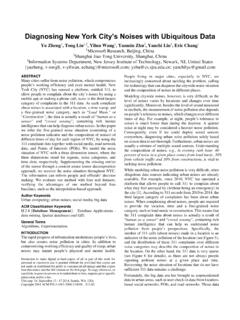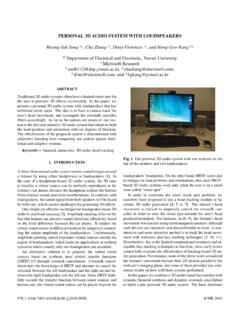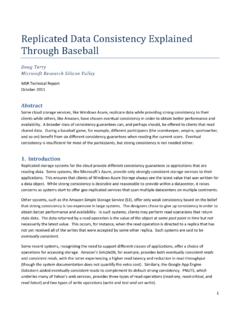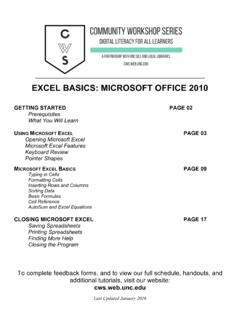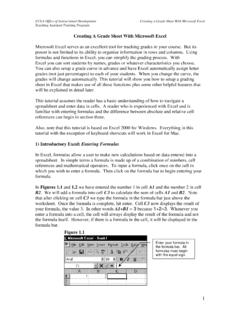Transcription of Cosmos - microsoft.com
1 Cosmos Big Data and Big Challenges Pat Helland July 2011 1 Outline Introduction Cosmos Overview The Structured Streams Project Some Other Exciting Projects Conclusion 2 What Is Cosmos ? Petabyte Store and Computation System About 62 physical petabytes stored (~275 logical petabytes stored) Tens of thousands of computers across many datacenters Massively parallel processing based on Dryad Similar to MapReduce but can represent arbitrary DAGs of computation Automatic computation placement with data SCOPE (Structured Computation Optimized for Parallel Execution) SQL-like language with set-oriented record and column manipulation Automatically compiled and optimized for execution over Dryad Management of hundreds of Virtual Clusters for computation allocation Buy your machines and give them to Cosmos Guaranteed that many compute resources May use more when they are not in use Ubiquitous access to OSD s data Combining knowledge from different datasets is today s secret sauce 3 OSD Computing/Storage Front-End On-Line Web-Serving Back-End Batch Data Analysis Crawling Internet Other Data User & System Data Data for On-Line Work Results Large Read-Only Datasets OSD Computing/Storage Front-End On-Line Web-Serving Back-End Batch Data
2 Analysis Crawling Internet Other Data User & System Data Data for On-Line Work Results Large Read-Only Datasets Cosmos and OSD Computation OSD Applications fall into two broad categories: Back-end: Massive batch processing creates new datasets Front-end: Online request processing serves up and captures information Cosmos provides storage and computation for Back-End Batch data analysis It does not support storage and computation needs for the Front-End Cosmos ! Cosmos : The Service Data drives search and advertising Web pages: Links, text, titles, etc Search logs: What people searched for, what they clicked, etc IE logs: What sites people visit, the browsing order, etc Advertising logs.
3 What ads do people click on, what was shown, etc We generate about 2 PB every day SearchUX is hundreds of TB Toolbar is many 10s of TB Search is hundreds of TB Web snapshots are many 10s of TB MSN, Hotmail, IE, web, Cosmos is the backbone for Bing analysis and relevance Click-stream information is imported from many sources and cooked Queries analyzing user context, click commands, and success are processed Cosmos is a service We run the code ourselves (on many tens of thousands of servers) Users simply feed in data, submit jobs, and extract the results 5 Outline Introduction Cosmos Overview The Structured Streams Project Some Other Exciting Projects Conclusion 6 Store Layer: -- Many Extent Nodes store and compress replicated extents on disk -- Extents are combined to make unstructured streams -- CSM ( Cosmos Store Manager) handles names, streams, & replication Store Layer EN EN EN EN.
4 Extent Extent Extent Extent .. Stream Foo Stream Bar Stream Zot Execution Layer Execution Layer: -- Jobs queues up per Virtual Cluster -- When a job starts, it gets a Job Mgr to deploy work in parallel close to its data -- Many Processing Nodes (PNs) host execution vertices running SCOPE code Job Mgr PN PN PN SCOPE Run/T SCOPE Run/T SCOPE Run/T Stream Foo Stream Bar Stream Zot Cosmos Architecture from 100,000 Feet 7 SCOPE Layer: -- SCOPE Code is submitted to the SCOPE Compiler -- The optimizer make decisions about execution plan and parallelism -- Algebra (describing the job) is built to run on the SCOPE Runtime SCOPE Layer Data = SELECT * FROM S WHERE Col-1 > 10 SCOPE Optimizer SCOPE Run/T SCOPE Run/T SCOPE Run/T SCOPE Compiler The Store Layer Extent Nodes: Implement a file system holding extents Each extent is up to 2GB Compression and fault detection are important parts of the EN CSM: Cosmos Store Manager Instructs replication across 3 different ENs per extent Manages composition of streams out of extents Manages the namespace of streams 8 Store Layer EN EN EN EN.
5 Extent Extent Extent Extent .. Stream Foo Stream Bar Stream Zot The Execution Engine Execution Engine: Takes the plan for the parallel execution of a SCOPE job and finds computers to perform the work Responsible for the placement of the computation close to the data it reads Ensures all the inputs for the computation are available before firing it up Responsible for failures and restarts Dryad is similar to Map-Reduce 9 Execution Layer Job Mgr PN PN PN SCOPE Run/T SCOPE Run/T SCOPE Run/T Stream Foo Stream Bar Stream Zot The SCOPE Language SCOPE (Structured Computation Optimized for Parallel Execution) Heavily influenced by SQL and relational algebra Changed to deal with input and output streams SCOPE is a high level declarative language for data manipulation It translates very naturally into parallel computation 10 Scope Job Stream-1 Stream-2 Stream-3 Stream-A Stream-B Input Output Input Arrives as Sets of Records Computation Occurs as Sets of Records Output Written as Sets of Records The SCOPE Compiler and Optimizer The SCOPE Compiler and Optimizer take SCOPE programs and create.
6 The algebra describing the computation The breakdown of the work into processing units The description of the inputs and outputs from the processing units Many decisions about compiling and optimizing are driven by data size and minimizing data movement 11 SCOPE Layer Data = SELECT * FROM S WHERE Col-1 > 10 SCOPE Optimizer SCOPE Run/T SCOPE Run/T SCOPE Run/T SCOPE Compiler The Virtual Cluster Virtual Cluster: a management tool Allocates resources across groups within OSD Cost model captured in a queue of work (with priority) within the VC Each Virtual Cluster has a guaranteed capacity We will bump other users of the VC s capacity if necessary The VC can use other idle capacity 12 Work Queue 100 Hi-Pri PNs VC-A Work Queue 500 Hi-Pri PNs VC-B Work Queue 20 Hi-Pri PNs VC-C Work Queue 1000 Hi-Pri PNs VC-D Work Queue 350 Hi-Pri PNs VC-E Outline Introduction Cosmos Overview The Structured Streams Project Some Other Exciting Projects Conclusion 13 Introducing Structured Streams Cosmos currently supports streams An unstructured byte stream of data Created by append-only writing to the end of the stream Structured streams are streams with metadata Metadata defines column structure and
7 Affinity/clustering information Structured streams simplify extractors and outputters A structured stream may be imported into scope without an extractor Structured streams offer performance improvements Column features allow for processing optimizations Affinity management can dramatically improve performance Key-oriented features offer (sometimes very significant) access performance improvements Stream A Sequence of Bytes Today s Streams (unstructured streams) Stream A Sequence of Bytes Metadata .. Record-Oriented Access New Structured Streams Today s Use of Extractors and Outputters Scope Stream A Unstructured Stream Extractor Metadata Scope Processing with Metadata, Structure, and Relational Ops Outputter Stream D Unstructured Stream Extractors Programs to input data and supply metadata Outputters Take Scope data and create a bytestream for storage Discards metadata known to the system source = EXTRACT col1, col2 FROM A Data = SELECT * FROM source <process Data> OUTPUT Data to D Metadata, Streams, Extractors.
8 & Outputters Scope has metadata for the data it is processing Extractors provide metadata info as they suck up unstructured streams Processing the Scope queries ensures metadata is preserved The new results may have different metadata than the old Scope knows the new metadata Scope writes structured streams The internal information used by Scope is written out as metadata Scope reads structured streams Reading a structured stream allows later jobs to see the metadata 16 Stream C Metadata Structured Stream Stream B Metadata Structured Stream Scope Stream A Unstructured Stream Extractor Metadata Outputter Stream D Unstructured Stream Scope Processing with Metadata, Structure, and Relational Ops Note: No Cosmos Notion of Metadata for Stream D -- Only the Outputter The Representation of a Structured Stream on Disk Is Only Visible to Scope!
9 By adding metadata (describing the stream) into the stream, we can provide performance improvements: Cluster-Key access: random reads of records identified by key Partitioning and affinity: data to be processed together (sometimes across multiple streams), can be placed together for faster processing Metadata for a structured stream is kept inside the stream The stream is a self-contained unit The structured stream is still an unstructured stream (plus some stuff) Streams, Metadata, and Increased Performance Stream A Metadata Cluster-Key Access Partitioning and Affinity Cluster-Key Lookup Cluster-Key Indices make a huge performance improvement Today: If you want a few records, you must process the whole stream Structured Streams: Directly access the records by cluster-key index How it works: Cluster-Key lookup is implemented by having indexing information contained in the metadata inside the stream The records must be stored in cluster-key order to use cluster-key lookup Cosmos managed index generated at structured stream creation Stream Foo Metadata (including index) A B C D E F G H I J K L M N O P Q Z Y X W.
10 A E J N Q W A D Lookup D Implementing Partitioning and Affinity Joins across streams can be very expensive Network traffic is a major expense when joining large datasets together Placing related data together can dramatically reduce processing cost We affinitize data when we believe it is likely to be processed together Affinitization places the data close together If we want affinity, we create a partition as we create a structured stream A partition is a subset of the stream intended to be affinitized together .. Scope Affinitized Data Is Stored Close Together Case Study 1: Aggregation SELECT GetDomain(URL) AS Domain, SUM((MyNewScoreFunction(A, B, ..)) AS TotalScore FROM Web-Table GROUP BY Domain; SELECT TOP 100 Domain ORDER BY TotalScore; Expensive Super Expensive Unstructured Datasets Structured Datasets (Sstream) (partitioned by URL, sorted by URL) Much more ef)
